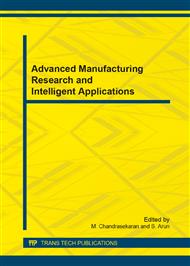p.112
p.116
p.120
p.124
p.128
p.132
p.137
p.142
p.146
Analytic Studies on the Computer Aided Design and Analaysis of Hydro Electric Barrel Turbine
Abstract:
Hydro electric barrel turbines can be used for extraction of clean energy from water flowing at velocity more than 1 m/sec. The kinetic energy available in the flow in water is converted into mechanical energy by means of a barrel having helical type projections and depressions. This is similar to helical milling cutter. The mechanical energy is converted into electrical energy by means of a pan type electrical generator, the output of which is stored in a battery and inverter and then is used. The specific advantage of barrel turbine is easy handling and environment friendly design, thus eliminating the need for environmental impact assessment studies. The proposed project consists of a CAD model of the barrel turbine which can be generated using CATIA, pro E softwares and analysis on this cad model will be performed. Analysis for the strength and power extraction capabilities shall be estimated using ANSYS fluid dynamics. Parameters such as diameter, the length of the turbine and variation of velocity of flow shall be studied in this work.
Info:
Periodical:
Pages:
128-131
Citation:
Online since:
July 2014
Keywords:
Price:
Сopyright:
© 2014 Trans Tech Publications Ltd. All Rights Reserved
Share:
Citation:


